“How do I change chords better?”
“Do I move UP to change chords or DOWN?”
I hear it all the time. When you’re first learning chords and chord progressions it can get confusing. Especially when you’re ready to break out of only playing chords in root position and start experimenting with inversions.
This lesson is going to show you 3 different patterns you can use right now to make your chord changes FASTER, SMOOTHER and BETTER.
We’ll be using the most common chord progression for our example, so you can focus on the changes rather than the chords themselves. It’s the 1-5-6-4 progression. If you don’t know what that is don’t worry I’ll show you in the video. But you can also find a lesson on it here.
And I’ve already mentioned that we’ll be using inversions for this lesson. If you don’t know what they are, don’t worry I’ll explain it all. But if you would like more information about chord inversions and how to play them, click here.
Ready?
We’re in the key of G major for this lesson, so the 4 chords we’ll be using will be:
G major (G-B-D), which is our 1 chord.
D major (D-F#-A), which is our 5 chord.
E minor (E-G-B), which is our 6 chord.
C major (C-E-G), which is our 4 chord.
Again, if those numbers are confusing, see this lesson.
For ALL of the combinations, the order of the chords will be G-D-Em-C. It will not change, but HOW we play those chords will, and that’s where the magic will happen.
The goal for all these combinations is to move our fingers as little as possible. I’ll explain what chord shapes we’ll be using, and include pictures so you can see what notes I’m playing.
We’ll start with a G chord in root position. It’s nice and easy:
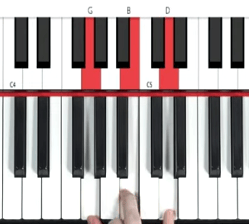
From there we’ll play the D major in 1st inversion. That means we only have to change 2 notes:
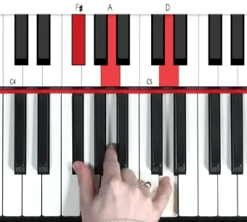
Notice how the D stays the same? That’s because it’s a common note in both the G chord and the D chord. We’ll be using common notes a lot in this lesson.
But there is no common note between D major and E minor, so to get to E minor we’ll move everything up to also play it in 1st inversion:
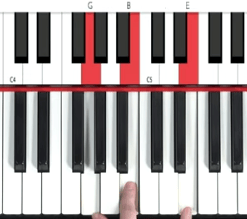
And finally, we’ll only change ONE note to get to a C major in 2nd inversion:
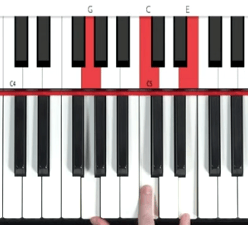
Take some time to study the chord shapes, and notice which notes change and which stay the same. If you’re at the piano, play these out slowly and identify the notes of the chord. Notice how the ORDER of the notes might be different, but every chord has the 3 notes we pointed out at the start of the lesson.
This is one of my favorite combinations. But it’s not the only option. Let’s keep going.
For this one, we’ll start with our G major in 1st inversion instead of root position. So the notes will still be G-B-D, but in a different order:
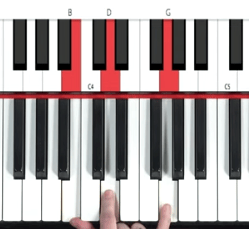
Just like in the first combo we changed two notes to go from the G to the D. We’ll do the same thing here. Can you guess which notes we’ll have to change?
The D will stay the same, but we’ll move the G down to an F# and the B down to and A to create a D major chord in 2nd inversion:
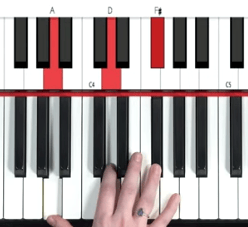
One thing to notice here is how I’m using my 4th finger (the ring finger) to play the F#. That allows me to change from the G to the D chord very fast! It’s a little trade secret 🙂
From here we’ll move everything up again to play the E minor also in 2nd inversion:
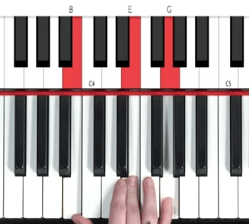
And now it’s time to move to the C major. Can you guess what note needs to change? There’s only one. The notes in a C chord are C-E-G, and we already have the E and the G notes. So we only have to bump up that B to a C and we have a C chord in root position:
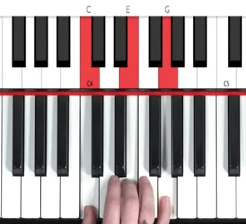
I hope you’re seeing the patterns that are emerging here. We’re exploring different chord inversions and demonstrating how they SOUND different.
For our first combo, we started with the G major in root position. For the second one, we started with the G in 1st inversion. Can you guess how we’ll start the next one?
If you guessed 2nd inversion, give yourself a round of applause! You’re exactly right:
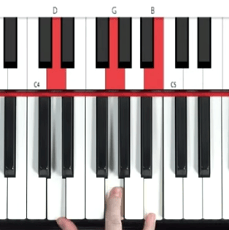
Once again, the notes are still the same. There’s still a G-B-D in the chord but the order is different. From this position we’re going to move to a D major chord, this time in root position:
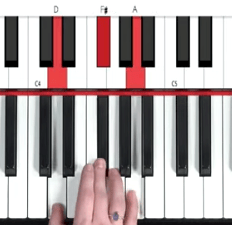
The D stays the same, while we bump the G and B down to F# and A. Now to move to the E minor we just move everything up again so we’re still in root position:
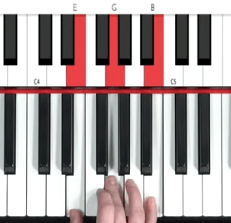
One more chord change to go. Hopefully by now you’ll know what note we need to change. The end result will be a C major chord in 1st inversion:
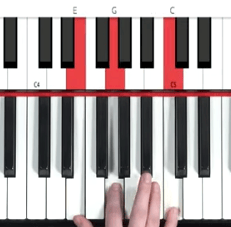
And those are the 3 patterns!
Remember, to change chords smoothly and faster, you want to look for ways to move the SHORTEST distance possible between two chords. That involves using chord inversions.
Inversions are just chords with the notes in a different order than the root position.
This lesson has been an example in the key of G major. But the principles and shapes can be applied to ANY major key.
So here’s the challenge. Figure out these same combinations in DIFFERENT key signatures. Try C major to begin with, then maybe F major. Practice these combos in as many keys as you can.
And start playing some songs using these progressions. You can find a few of them here: 4 Songs that are Perfect for Beginners
Have so much fun!
Lisa Witt has been teaching piano for more than 20 years and in that time has helped hundreds of students learn to play the songs they love. Lisa received classical piano training through the Royal Conservatory of Music, but she has since embraced popular music and playing by ear in order to accompany herself and others. Learn more about Lisa.
/marketing/pianote/promos/april/banner-bg-m.webp)
We use cookies for traffic data and advertising. Cookie Policy »
/marketing/pianote/promos/april/banner-title.webp)